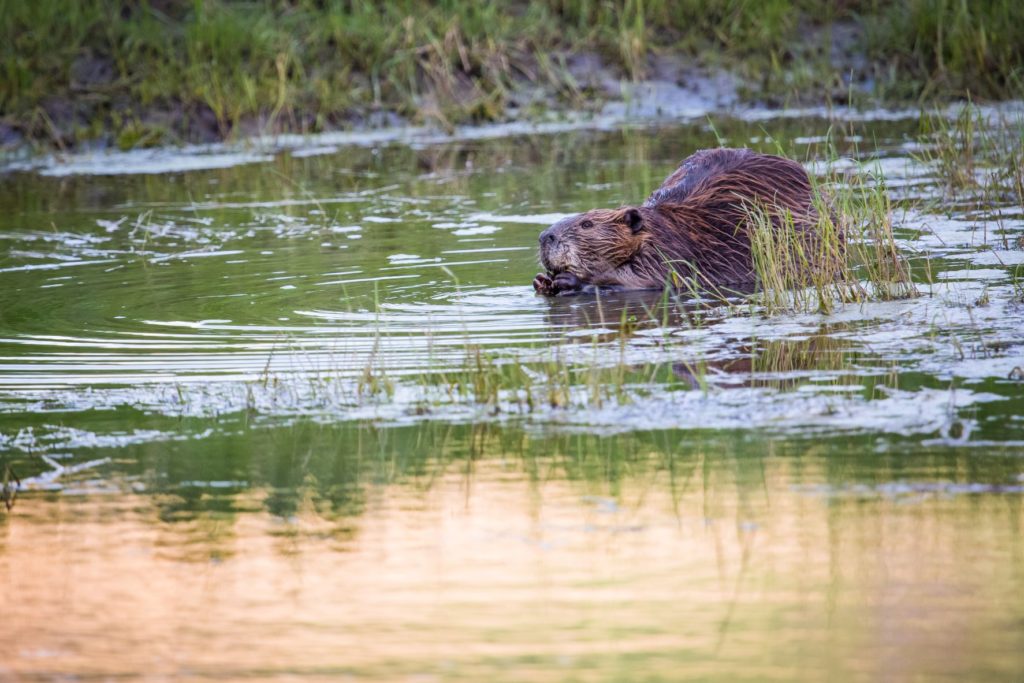By Jeff Burrell – Hydrologist and former director of the Wildlife Conservation Society Northern Rockies Program.
Cover Photo from Neil Herbert (Yellowstone National Park)
There’s been a growing appreciation of the important role beavers can play in creating and sustaining the ecological health of watersheds. As the former (now retired) director of the Wildlife Conservation Society Northern Rockies program, I oversaw a number of long term research efforts that helped establish that beavers, by way of their many activities, benefit a wide range of wildlife species native to the Greater Yellowstone Ecosystem. Migratory song birds and waterfowl, amphibians, moose, bears, and many more of our wildlife depend on healthy riparian and wetland habitats that beavers help to create and sustain. People as well are beneficiaries. The riparian and wetlands that beavers can help create and maintain filter out sediments and pollutants, reduce flash flood potential damage, and act as natural fire breaks, as well as providing some of our best scenery.

In parallel with this appreciation for the role that beavers can play, there’s been a deepening desire to see more beavers in our watersheds. The 19th and early 20th centuries witnessed the along complete decimation of many of our wildlife species, including beavers. Beavers have made some recovery, but best estimates are that the current population is less than 10 % of the likely original. This number is simply too small for beavers to fill the desired role as major watershed eco-engineers.
So we need them and want them but can we get them back in the numbers and locations needed? To do so we need to overcome two major challenges. First, for too long beavers have been viewed as nuisance animals, with little protection. Outreach and education efforts will be essential. For property owners, help them better understand the benefits of having an active, strong beaver population for themselves, their neighbors and their community AND that there are effective ways to substantially avoid potential property damage by beavers without removing beavers. For land and wildlife management agencies, beaver restoration must be a priority AND should be seen as an essential aspect of watershed habitat conservation and climate change adaptation. A number of organizations, such as Wyoming Wetlands, Wyoming Wildlife Advocates, and the Northern Rockies Conservation Cooperative are active on this front
The second challenge is more fundamental. Prior to my work with the Wildlife Conservation Society, I worked as research geologist studying the watersheds of the western U.S. It was through this work that I came to appreciate what a beneficial force beavers can be. But I also saw that as a result of the decimation of beaver populations, and a result of many poor watershed management actions, the watersheds of the West and the GYE cannot as they are now support the numbers beavers needed. Too many watershed channels are deeply incised, riparian zones if present at all have been reduced to narrow decadent bands alongside streams, and the water tables too depressed to support year round flows beavers need.
I am working to help tackle this second challenge. First, we need better information on beavers: where are they and what are they doing. In partnership with the Jackson Hole Wildlife Foundation, Grand Teton National Park and Bridger Teton National Forest, next spring I will start a citizen science effort to survey Grand Teton National Park and Bridger Teton National Forest: where are beavers now and what are they doing, and where have then been active in the not too distant past and what were they doing. Beavers leave telltale indications, and with training I will help citizen scientists learn how to identify, assess the age of (current, recent, near past and distant past), and map beaver sign. We will be using a beaver habitat model created by the Utah State University as a guide. This information will provide needed information on beaver habitat use now, as well as trends in habitat use during the past several decades (increasing, decreasing, shifting?). We will also identify where with some minimal actions, habitats could be improved to allow expansion of beavers into these areas of the watersheds.
If you would like to participate in or support this work, please contact Kate (kate@jhwildlife.org) or Hilary (hilary@jhwildlife.org).
